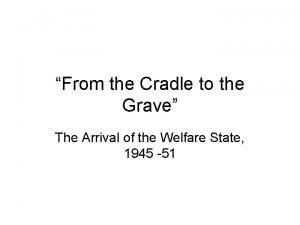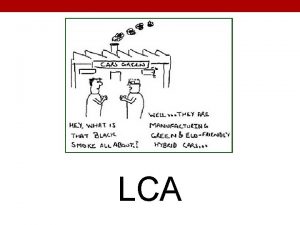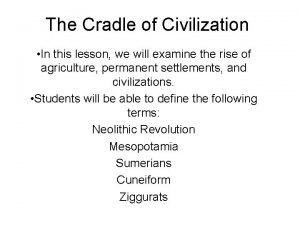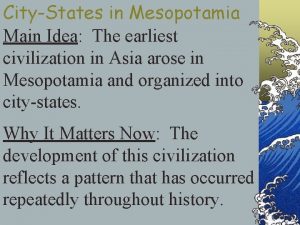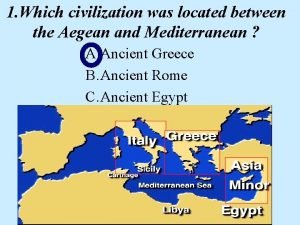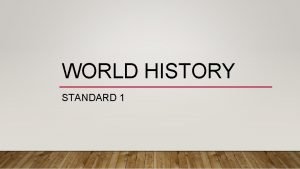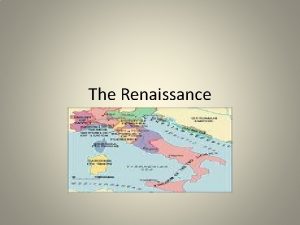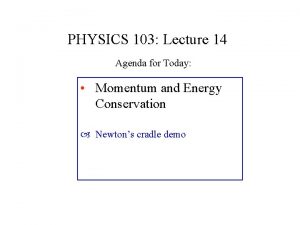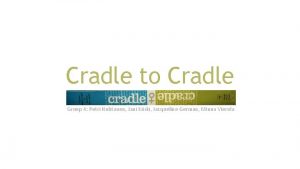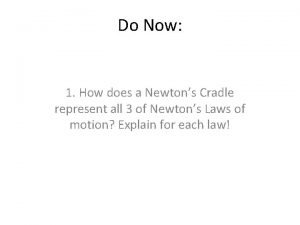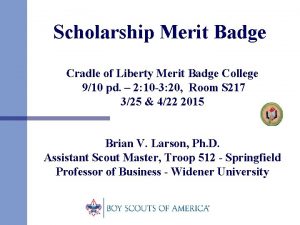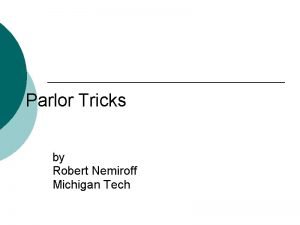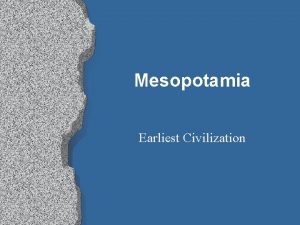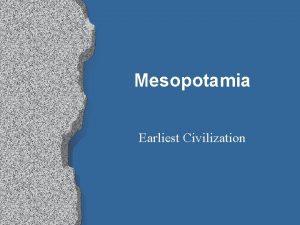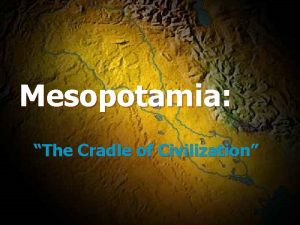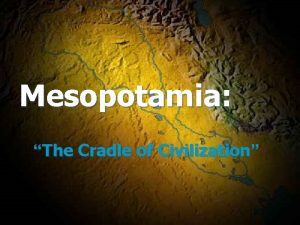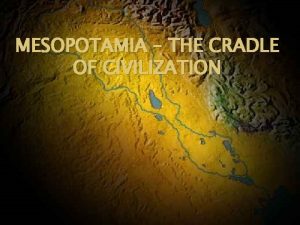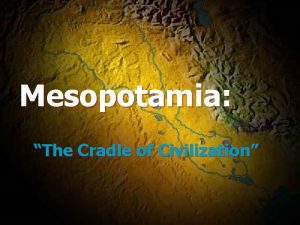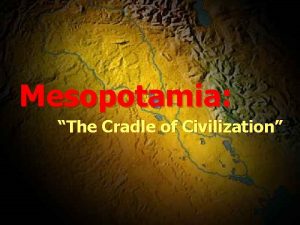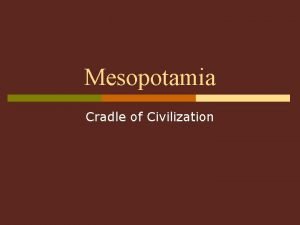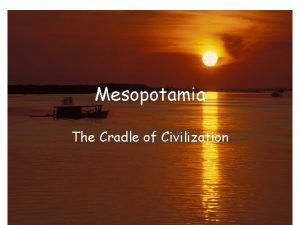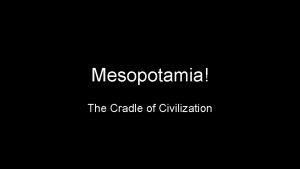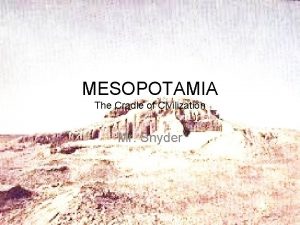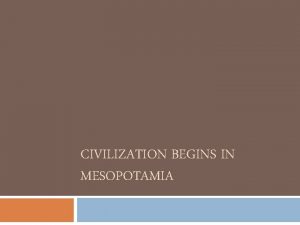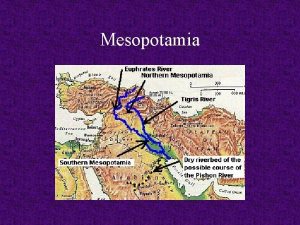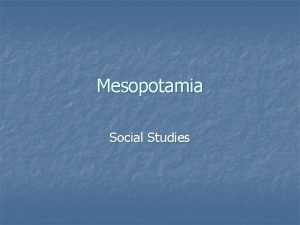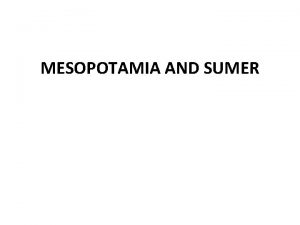Mesopotamia The Cradle of Civilization Earliest Civilization the





















- Slides: 21

Mesopotamia: “The Cradle of Civilization”

Earliest Civilization: the Fertile Crescent n earliest of all civilizations n Mesopotamia Greek for “between the rivers” n Lasted for approximately 3000 years n Its peoples were the first to – permanent settlements – Tigris River and Euphrates River – present day Iraq –irrigate fields –devise a system of writing –develop mathematics –invent the wheel –work with metal –devise a written law code


Geographic Conditions n Little rainfall n Hot and dry climate n Wind and rain storms n catastrophic flooding in spring n Arid soil containing little minerals n No stone or timber resources – muddy river valleys in winter

Then why live in Mesopotamia? NATURAL LEVEES: embankments produced by build-up of sediment over thousands of years of flooding

Natural Levee n create a high and safe flood plain n make irrigation and canal construction easy n provide protection n the surrounding swamps were full of fish & waterfowl n reeds provided food for sheep / goats n reeds also were used as building resources

Government n Political structure - early form of democracy n Frequent wars led to the emergence of warriors as leaders n Eventually rise of monarchy n Followed leadership of god of the city – interpreted by a council of leading citizens or priests or leader of the city - king

Sumerians Ruins of Babylon in present day Baghdad Southern Mesopotamia 3500 -2000 BCE n Irrigated fields and produced 3 main crops – barley, dates and sesame seeds – built canals, dikes, dams and drainage systems n n n developed cuneiform writing invented the wheel Abundance of food = increase of population First city of the world Developed a trade system with bartering n Individuals could only rent land from priests n The Sumerians were not successful in uniting lower Mesopotamia – mainly barley but also wool and cloth for stone, metals, timber, copper, pearls and ivory – controlled land on behalf of gods – most of profits of trade went to temple Sumerian city of Lagash

Akkadians Akkad- northern Mesopotamia 2340 – 2180 BCE n Leader Sargon the Great – unified lower Mesopotamia after conquering Sumerians in 2331 BCE Established capital at Akkad n Spread Mesopotamian culture n Akkadians conquered by invading barbarians by 2200 BCE n Bronze head of Sargon

Babylonians 1830 -1500 BCE KING HAMMURABI n n Conquered Akkad and Assyria Built n Economy based on agriculture and wool Individuals could own land Artisans and merchants could keep most profits and even formed guilds Grain used as the medium of exchange – emergence of currency: § shekel = 180 grains of barley; § mina = 60 shekels Mina was eventually represented by metals - one of first uses of money – still based on grain n • Babylonians reunited Mesopotamia in 1830 BCE • central location dominated trade and secured control • YET AGAIN, Mesopotamia was not unified for long… n n – walls to protect the city – canals and dikes to improve crops Hammurabi’s Legacy – law code

Code of Hammurabi 1800 BCE To enforce his rule, Hammurabi collected all the laws of Babylon in a code that would apply everywhere n First and most extensive law code from the ancient world n Code of 282 laws inscribed on a stone pillar placed in the public hall for all to see n n Set of divinely inspired laws; as well as societal laws n Punishments were designed to fit the crimes as people must be responsible for own actions n Origin of “eye for an eye…” – If a son struck his father, son’s hand would be cut off n Consequences for crimes depended on rank in society – Poor = hand off, nobles = pay a fine Hammurabi receiving law code from sun god Shamash

Religion n Enlil – supreme god of air Polytheistic – over 3600 gods and demigods n Kingship created by gods n Gods lived on the distant mountaintops n Each city was ruled by a different god n Kings and priests acted as interpreters – king’s power was divinely ordained Enki, god of water, life, mediation – they told the people what the god wanted them to do – by examining the liver or Shamash sun god and lungs of a slain sheep Ishtar, goddess of fertility, war, sex

Ziggurats n Temples dedicated to the god of the city n Made of layers of mud bricks in the shape of a pyramid Ziggurat of Ur -2000 BCE – On platforms due to constant flooding n Temple on top god’s home n Temples evolved to ziggurats n Famous ziggurat was Tower of Babel – beautifully decorated – a room for offerings of food and goods – a stack of 1 -7 platforms decreasing in size from bottom to top – over 100 m above ground and 91 m base

Development Of WRITING

Development of Writing n Click here to see the development of writing from pictograms to cuneiform Pictograms: picture to show meaning n Ideograms: signs to represent words / ideas n Phonetics: signs to represent sounds n *Phonetics are the basis of most writing systems

Writing - 3500 BCE n Allowed – – – n transmission of knowledge the codification of laws records to facilitate trade/farming CUNEIFORM meaning “wedge shaped” – Wet clay tablets with the point of a reed – dried in the sun to make a tablet n Scribes only could read and write – served as priests – record keepers – accountants n Spread to Persia and Egypt – vehicle for the growth and spread and exchange of ideas among cultures

How to do Cuniform

Gilgamesh - The First Epic Poem Over 4000 thousand years old, written on 12 clay tablets n Epic battle between Enkidu -wild man, good heart and Gilgamesh – controlling king n The two became friends and had adventures n Made the gods angry so they killed Enkidu – Gilgamesh wanders the underworld in grief n Why important? • Earliest known author – Sin-leqi-unninni • Mentions great flood similar to story of Noah’s Ark

Royal Tombs of Ur n Excavated from 1922 to 1934 n Extravagant jewelry of gold, cups of gold and silver, bowls of alabaster, and extraordinary objects of art and culture Jewellery from Royal Tombs of Ur 3000 BC Great Death Pit • mass grave containing the bodies of 6 guards and 68 servants • drank poison to accompany the kings and queens in the afterlife

Mathematics and Science Mesopotamia, specifically Babylon used a mathematical system based on sixty n Some parts of the ‘base-sixty’ system still remain today n – 360 degrees in a circle – 60 seconds in a minute – 60 minutes in 1 hour n Calendar based on cycles of the moon – number of days between the appearance of two new moons was set as a month – 12 cycles made up a year

Legacies of Mesopotamia n n n Codified laws Ziggurats – places of worship Cuneiform writing Irrigation Metal working, tools n n Trade networks Transportation – the wheel Mathematics and calendar Prosperous living based on large scale agriculture
 Mesopotamia the cradle of civilization worksheet answers
Mesopotamia the cradle of civilization worksheet answers Cradle to grave housing report
Cradle to grave housing report Cradle to cradle design
Cradle to cradle design Cradle to grave cradle to gate
Cradle to grave cradle to gate Cradle to cradle boek
Cradle to cradle boek The cradle of civilization
The cradle of civilization The earliest civilization in asia arose in
The earliest civilization in asia arose in The earliest aegean civilization was located
The earliest aegean civilization was located Conclusion of the mesopotamian civilization
Conclusion of the mesopotamian civilization Conclusion of comfort devices in nursing
Conclusion of comfort devices in nursing Cradle to grave
Cradle to grave Cradle of the renaissance
Cradle of the renaissance Cradle alignment techniques
Cradle alignment techniques Cradle to grave
Cradle to grave Examples of okonkwo's heroic behavior
Examples of okonkwo's heroic behavior Newton's cradle
Newton's cradle Golden cradle kindergarten
Golden cradle kindergarten Sven jani
Sven jani Newton's cradle drawing
Newton's cradle drawing Scholarship merit badge
Scholarship merit badge Scholarship merit badge
Scholarship merit badge Newton's cradle
Newton's cradle

